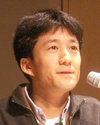
Members
A02 : Minority in Biology
We will analyze the relationship between signal transduction and response to stimuli terms of Poisson property and spatial-hierarchy, and determine the chemotactic factor that can undergo light stimulation to induce chemotaxis. Subsequently, we will analyze the dynamics of the bound/unbound proteins, rotational diffusion, and translational diffusion at a single molecule level to obtain the time constant and duration of the response after stimulation (Ishijima, Tochio).
We will focus on the conformational fluctuation of chromatins and alterations in the number of proteins related to gene expression that is derived from the limited biolmolecules (minority issue). At first, we will measure the conformational fluctuation of chromatin. Next, we will investigate the effect of the structural fluctuations on the chemical reaction and the reaction network that is composed of limited number of biomolecules by using computational simulation and manipulating the number of molecules for the modulation of gene expression (Maeshima).
To regulate the number of expressed gene products, the critical issue to be addressed is the turnover rate of proteins (the regulation of gene transcription/translation) and protein degradation. Even if multiple molecules operate as one complex, each subunit has different protein abundance and turnover rate. Physiological significance (or potential vulnerability) of such variance is largely unknown. This project focuses on this question by considering the biological rhythmicity driven by known gene products in a model system, particularly focusing on the role of the biomolecules with lower expression level (Ueda, Ukai and Nakajima).
A02-1 : Minority issues in signal transduction: analysis of Poisson property in biological systems

- Name :
- Ishijima, Akihiko HP
- Affiliation :
- Graduate school of Frontier Biosciences, Osaka University
- Major :
- Biophysics
Purpose
Interactions and bio-chemical reactions within cells are a result of reactions among limited number of biomolecules existing in an extremely crowded environment, which fairly differs from one in which large number of molecules react with much large degree of freedom in vitro. To understand the underlying mechanism, it is essential to observe the behavior of the small number of molecules within the cells and construct a novel theory based on the results.
Previous studies by researchers have not progressed far enough to improve our understanding of the entire bio-molecular reactions within cells, because they only measured single parameters. The purpose of this project is to understand the underlying mechanisms involved in the dynamic range of sensing the external stimuli by the cells and transmitting these signals inside the cell, using various novel techniques such as caged compounds (that can react in sub-milliseconds), diamond nano-particles (that can aid in determining the conformational changes of the receptor proteins on the cell), and the simultaneous optical observation of multiple motors and Raman spectroscopy.
| Name | Affiliation | Major | Role | |
|---|---|---|---|---|
| Co-Investigator (kenkyu-buntansha) | ||||
 |
Tochio, Hidehito | Graduate school of Science, Kyoto University | Structural Biology, Nucleic resonance | Structural analysis of protein in cell |
A02-2 : Small number issue in the genome: How can only two sets of genes on the long genome DNA be searched and read out?

- Name :
- Maeshima, Kazuhiro HP
- Affiliation :
- Biological Macromolecules Laboratory, National Institute of Genetics
- Major :
- Biophysics
- Role :
- Imaging of fluctuations in chromatin conformation
Purpose
The human genomic DNA that is about 2 m in length is organized into a cell nucleus with a volume of only 1 picoliter. Each genome has essentially only two sets of genes. In order to activate a certain gene, a protein factor, normally present in low numbers, searches the entire genome and targets the specific gene. This process is a good example of the “small number issue” in cell biology. How is the human genomic DNA organized into a small nucleus? How can a certain target gene be searched and read out? We plan to address these questions based on imaging and computational modeling.
| Name | Affiliation | Major | Role | |
|---|---|---|---|---|
| Co-Investigator (kenkyu-buntansha) | ||||
 |
Taniguchi, Yuichi HP |
RIKEN QBiC | Biophysics | Single molecule observation in nucleus |
| Co-Investigators (renkei kenkyusha) | ||||
 |
Takahashi, Koichi HP |
RIKEN QBiC | Computational science | Support for techniques of molecular simulation |  |
Yoshimura, Shigehiro HP |
Graduate school of Biostudies, Kyoto University | Molecular biology | Support for study of nuclear transportation |
A02-3 : Minority in biological rhythm

- Name :
- Ueda, Hiroki
- Affiliation :
- Graduate school of Medicine and Faculty of Medicine, The University of Tokyo
- Major :
- System biology
- Role :
- Experimental design
Purpose
Previous studies and our current project suggest that the expression level of circadian core factors, that mostly work as transcription regulators, are generally low. Given this low protein abundance, it is still not understood how the preciseness of the circadian clock is maintained. The circadian clock is resistant to fluctuations in the environmental conditions (e.g. changes in the temperature), but the phase of clock is adjustable to changes in light condition and abrupt shifts in temperature, allowing the clock to adapt to seasonal changes and “jet lag”. How does the circadian clock manage to maintain precise period and adjustable phase? We aim to answer this question by focusing on the condition in which the protein and gene regulatory network operates in relatively low molecular numbers. Specifically we will focus on the following two aspects regarding the regulation of circadian period; 1) relationship between the protein turnover rate and the preciseness of circadian period and 2) the contribution of the enzymes that modulate circadian period and phase to the regulation against environmental changes.
| Name | Affiliation | Major | Role | |
|---|---|---|---|---|
| Co-Investigator (kenkyu-buntansha) | ||||
 |
Ode, Koji |
Graduate school of Medicine and Faculty of Medicine, The University of Tokyo | Biological chemistry and Molecular biology | in celluro/in vitro experiment |
| Co-Investigators (renkei kenkyusha) | ||||
 |
Ukai, Hideki HP |
RIKEN QBiC | Molecular and cellular biology | Support for in celluro experiment |
| Co-Investigator (kenkyu-buntansha) 2011~2012 | ||||
 |
Nakajima, Masato | Department of Anatomy and Neurobiology, Kinki University | Biological chemistry | Support for in vitro experiment |